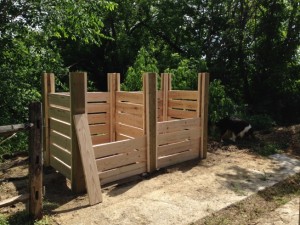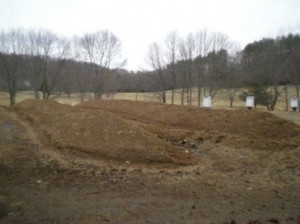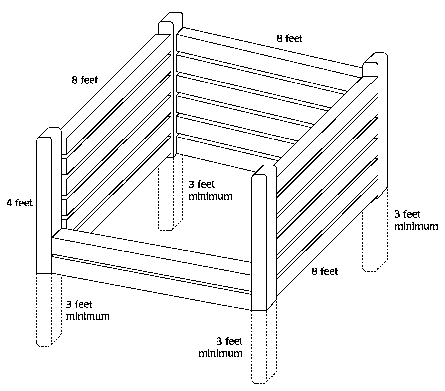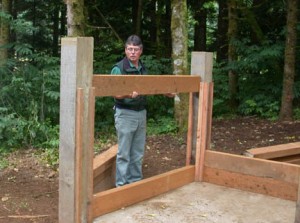Your cart is currently empty!
Composting Horse Manure for Water Quality Protection
Composting Horse Manure for Water Quality Protection
 Even small horse farms can produce a significant quantity of manure. Every day, a mature horse can produce up to a cubic foot of manure. When horse manure is not managed properly it can leach nutrients and pathogens to surface and groundwater.
Even small horse farms can produce a significant quantity of manure. Every day, a mature horse can produce up to a cubic foot of manure. When horse manure is not managed properly it can leach nutrients and pathogens to surface and groundwater.
Excess nutrients and other contaminants can upset the ecological balance in streams, lakes and ponds, causing environmental damage. A manure pile’s location on the landscape and its interaction with rain and snowmelt contribute to the amount of polluted runoff entering local waterways. Composting horse manure can prevent polluted runoff from entering waterways, quickly break down soiled bedding material and can yield a valuable, soil-building product.
Downloadable Construction plans: Horse Compost Bin Design
Selecting the best composting method for your site
Composting Structure
A multi-bin system is ideal for horse farms with one to five average-sized horses. Larger horse farms will have the most success managing compost in long windrows or through a commercial compost operation.
A 2-bin compost system
Windrow compost system
Site Selection
It is necessary and practical for most horse owners to store manure close to their barns. However, convenience should be balanced with an effort to avoid placing compost piles or bins in areas that are environmentally sensitive or could generate polluted runoff. To choose an appropriate place for your bins (or windrows), it is important to understand the soil characteristics on the site and how water (including snowmelt) moves across the landscape on your property.
Bins should be placed in areas that are “high and dry” by avoiding wet areas or seasonal drainage areas. It is also best to avoid building a bin on top of highly compacted soils or on soils that have a low infiltration capacity.
Bin Size and Quantity
The exact volume of manure storage needed depends on many factors, including the size and breed of horse, their activity level and the type of bedding used.
An average, exercised horse (1,100 lbs.) will produce .92 ft3/day of waste
and the average horse owner uses .75 ft3/day of bedding per horse.
An average horse can produce 1.67 ft3/day in waste material!
It is important to plan for the amount of storage you will need over time. For example, if a horse owner has three horses and needs to store and compost manure for six months of the year, they will need to  store nearly 1,000 cubic feet of manure and bedding. In this case, three 8’x8’x6’ compost bins would be sufficient. As the manure is stored over time, it will reduce in size, but it is better to have more space rather than not enough.
store nearly 1,000 cubic feet of manure and bedding. In this case, three 8’x8’x6’ compost bins would be sufficient. As the manure is stored over time, it will reduce in size, but it is better to have more space rather than not enough.
Managing Compost
- Compost should be kept moist, but not soaking wet (a cover for the bins will help over-watering). Manure that is too wet will not compost and will create undesirable conditions for the microbes that break down the manure.
- If piles are turned with greater frequency, more oxygen is introduced into the piles, and the composting process will occur faster.
- A well-maintained pile that is kept at the right moisture content and turned every few weeks will transform into usable compost faster than a pile that is not managed.
- If a pile is not managed, it will still break down into compost, however it will take a longer time and horse owners may want to consider having more storage available
Importance:
- Composting horse manure is also good for horse health by reducing flies and killing parasites and pathogens.
- Composting manure can simplify your manure management by reducing manure volume by 40-60%.
- Composted manure will kill weed seeds and when applied, can enrich your pastures and improve soil health.
- Composting manure can protect water quality by preventing nutrient pollution from entering waterways.
Remember!
Vermont’s winter spreading ban applies to horse manure too! Don’t spread in the winter, when the ground is frozen, on flood plains or wet areas and don’t spread near well heads or other groundwater sources.
Composting for Horse Health
- Reduce flies. A well-managed compost pile will reach temperatures high enough to kill fly eggs and larvae in manure. By reducing the amount of uncomposted manure you have, you’ll also r
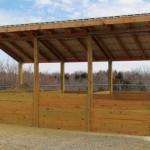 educe breeding grounds for flies.
educe breeding grounds for flies. - Kill parasites and pathogens. The high temperatures achieved through composting also kill worms and pathogens (organisms such as bacteria, viruses, fungi, and protozoa that are capable of producing an infection or disease). This is especially important if you are spreading your manure in the same fields your horses graze in or on vegetable gardens.
Composting for Convenience and Aesthetics
- Reduce odors. A well-managed compost pile will be free of the odors often associated with an uncomposted manure pile.
- Cut your pile in half. Composting reduces bulk and has 40 to 60 percent less volume and weight than uncomposted manure. That means you can reduce the amount of your manure pile by about 50 percent by composting!
- Kill weed seeds. The high temperatures achieved through composting will kill most weed seeds.
- Improve marketability. Compost is much more marketable than uncomposted manure and is often used by topsoil companies, landscapers, nurseries, and organic farmers. You may be able to sell your compost and actually make money out of that mountain of manure!
- Even out grazing patterns. Horses grazing in pastures spread with composted manure (instead of fresh manure) are more likely to graze normally and are less likely to restrict grazing to areas with the thinnest application rates.
Composting for Healthy Soil
- The addition of compost to soil improves aeration and water retention. Adding compost to heavy clay soil loosens the packed soil by opening up pore spaces that, like little tunnels, carry air and water down into the soil. Sandy soils, which tend to let water drain away too rapidly, are also improved with the addition of compost.
- Supply nutrients. When fresh manure is spread on a field, about 50 percent of the nitrogen is in a highly soluble form and will be washed out by rain when it is spread on a pasture. In compost, however, 95 to 97 percent of nitrogen has been converted to a much more stable form and will be slowly released, allowing plants to use it over a longer period of time. Compost doles out nutrients slowly when plants are small and at greater rates as soil temperatures warm up and the major growth period begins.
Composting for The Environment
- Protect water quality. Because the composting process converts nitrogen into a less soluble form, it is less likely to be washed out of manure and into ground water and surface water. Excessive amounts of nitrate in drinking water can cause health problems such as blue baby syndrome and may be linked to cancer and birth defects.
- Protect fish and shellfish. When rain falls on soil rich with compost, raindrops seep into it. When rain falls on packed soil rain runs off the surface, creating erosion and carrying soil particles to nearby waterways. Sediment can smother fish eggs and make water cloudy, making it more difficult for fish to find insects to eat. Raw manure also contains fecal coliform bacteria which may not necessarily produce disease, but can indicate the presence of other bacteria that may cause infections, hepatitis, and other illnesses. Composting kills most of these coliform bacteria as well as viruses and parasites that may be a concern to human health.
- Conserve our natural resources. Using compost instead of chemical fertilizers can reduce our use of non-renewable resources like natural gas. Approximately two percent of the natural gas consumed in the United States goes into the manufacturing of nitrogen fertilizer.
Horse Manure Compost Bin Design
Wooden Bins
Wooden bins can be constructed to any dimension to meet a horse owner’s needs, this example shows designs for
8ft x 8ft x 4ft or 4ft x 4ft x 4ft bins. The bins can be built stand alone, or in rows of two or three.
- 8’x2”x2” boards
- 8’x8”x2” landscape timbers
- Landscape fabric
- Deck screws
The quantities of materials vary depending on bin size and whether bins are built adjacent or stand-alone:
Wooden Bin Building Instructions
- Identify the four corners of each bin, which is determined by the bin dimensions: 8’x8’x4’ or 4’x4’x4’ and number of bins to be built adjacent to each other.
- Dig post holes. Post holes will be 2’-3’ deep.
- Insert an 8’x6”x6” post at each corner hole and stabilize. The corner posts are treated wood and must be wrapped in landscape fabric.
- Cut 8’x2”x2” boards in half to 4’x2”x2”. These boards will be used to make slats for the landscape timbers.
- Using the deck screws, attach two 4’ x 2” x 2” boards vertically to each side of the posts as demonstrated in the photograph below. These boards will act as guides and will hold the sides of the compost bin (landscape timbers) in place. A stand-alone compost bin will have four boards attached to each post on the inside corners of the post. If an adjacent bin is installed, six boards will be attached to the post.
Example of board placement along posts to make slats
- For 8’x8’x4’ bins: slide the 8′ x 2″ x 8″ timbers between the slats created from the mounted boards, stacking the timbers into place. Small sections of wood can be inserted between each board to create some space between each slat, for the purpose of allowing air to flow more freely into the pile and speed up the
 composting process.
composting process. - For 4’x4’x4’ bins: cut the 8’x2”x8” timbers in half and slide into place
- If multiple bins are to be installed together, build out from one bin. The wall of the first constructed bin will be shared with the adjacent bin. Follow the steps above for adjacent bins.
Example of timber placement in constructed slats
Important Concerns:
Persistent Herbicides
If you use persistent herbicides (defined below) on your grazing lands, then your compost must not leave your property. You are not able to sell your compost commercially. Compost that contains persistent herbicides will kill many sensitive plants, including many common garden vegetable plants.
(Information excerpted from the US Composting Council) compostingcouncil.org
The Environmental Protection Agency (EPA) defines herbicides as chemicals used to manipulate or control undesirable vegetation. Persistent herbicides are a class of systemic herbicides that are used to control a wide variety of broadleaf weeds. These herbicides are formulated to survive multiple years of exposure in a growing environment. We are specifically concerned with the relatively new class of herbicides called “pyridine-carboxylic acids”. They are typically designed for use in hayfields, horse pastures, golf courses, right-of-ways, and lawns to kill off unwanted weeds and to remain effective for several months to years. These herbicides do not impact grasses.
There are a number of compounds that fall into the category of persistent herbicides. The most prevalent are Clopyralid (Dow Agrosciences), Aminopyralid (Dow Agrosciences, 2005), Aminocyclopyrachlor (DuPont, 2010), and Picloram (Dow Agrosciences). Less prevalent compounds in the same class include fluroxypyr, dopyralid, and triclopyr. Many of these compounds appear on labels in slightly different variations making identification by the untrained applicator or a testing lab difficult.
Persistent herbicides are relatively new compounds that have been formulated by the manufacturers specifically to be resistant to biological degradation. While most residual traces of herbicides typically breakdown in a compost pile in a matter of days, the molecular bonds joining these particular compounds can be resistant for months or even years.
According to the EPA, exposure to Clopyralid is not harmful to people or animals at the low levels present in compost. In fact, people that have applied this herbicide to their lawns have a much higher concentration of Clopyralid in their soil than will be found in compost. The primary environmental concern from this herbicide is its effect on sensitive plants. If vegetables grown in soil treated with herbicide-contaminated compost manage to produce anything, the vegetables are safe to eat.
For more information on composting horse manure, please email: info@winooskinrcd.org

